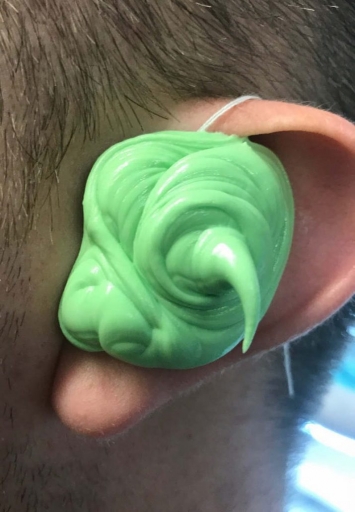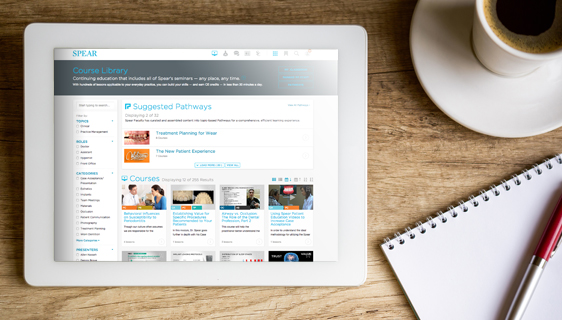“I’m 29 years old. I shouldn’t be having trouble hearing.” That’s the paranoid thought that would always pop in my head every time I had to ask someone, “What? What did you say?” Or any time I had to just pretend I heard what they said by nodding my head, giving a subtle smile and hoping that they asked a yes-or-no question or said something funny.

I work in an office with older air-turbine handpieces that have seen better days. After having worked with electric handpieces for a few years, I’ve become more aware of how much louder my current handpieces are. Most of the time, it’s tolerable and for better or for worse, I’ve become accustomed to it. But sometimes I find myself wincing and shrugging my shoulders, attempting to cover my ears.
I decided it was time to get a baseline hearing exam to see where I really stood and to find out whether my hearing is truly below-average for my age, or if I was just being overly paranoid. I get my eyes checked routinely and blood work biennially, so it seemed that my hearing would be just as important to keep tabs on, especially considering the loud workplace environments we spend most of our time in.
Many studies have been done measuring the sounds levels of dental offices, varying dental equipment and the prevalence of hearing loss or tinnitus in dental professionals. I was actually amazed at the number of results that popped up with a simple Google search of “hearing loss in dentists”.
In dental school, we were taught about how to protect our eyes from flying debris, our backs from poor ergonomics and ourselves from contaminated needle sticks. However, I can’t remember an instance where anyone ever recommended ear protection for the predictably loud and unavoidable noise level of the typical dental office, or the even louder dental school clinic.
OSHA guidelines limit the exposure of a worker to time-weighted averages of 90 decibels (dB) over an 8-hour day, or no more than two hours of exposure to sounds over loud 100 dB. While most air-driven handpieces seem to range in the area of 80-90 dB, some older handpieces have been measured at just over 100 dB12.
However, these are isolated measurements of the handpiece by itself. Another study showed that if you add in the sound of a high-vac suction, the average sound level could average close to 100 dB when measured at operator working length3.
While most dental professionals are not exposed to these sounds for every minute of every day, I think we are definitely skirting the thresholds. Once you factor in the hygienist next door using the ultrasonic scaler, the associate dentist in the next operatory running their handpiece, and the assistant in the lab using the model grinder, I think we underestimate the constant bombardment of high-level noise we face over long periods of the day.
Additionally, there is enough evidence that suggests that dentists have worse hearing thresholds than our medical counterparts and a higher incidence of tinnitus to make me want to take better precautions against noise-induced hearing loss34
For the hearing test, the audiologist had me sit by myself in a small, insulated, soundproof room. I was given headphones to put on and joystick with a small button to hold on to. During the test, a series of beeps were played through one ear at time at varying frequencies and intensities, and my job was to press the button when I could hear the beep. Throughout the process, I thought I was doing pretty well, proud of myself for picking up on what I thought were the faintest of noises.

Turns out my hearing was well within the normal range - nothing spectacular, but no sign of hearing loss. The graph below shows my results. The red and blue lines are tracking my right and left ears, respectively, with the Y-axis measuring my threshold hearing levels and the X-axis denoting the frequency. Interesting tidbit: people can hear sounds at negative decibel values. Zero decibels is not actually the absence of sound, but rather a reference value based on what might be considered a barely detectable sound, at the ear’s most sensitive frequency. Even though my hearing was normal, I decided I did want to take steps to protect it considering I have most of my career ahead of me.

After speaking with the audiologist, we decided on custom-molded ear protection. I’ve always had trouble getting ear buds to stay in place, and I did not want to risk having them fall out directly above a patient with a wide open mouth. While generic, disposable foam earplugs may work for some people, and will definitely block out quite a bit of noise, you typically have to take them out to talk because they block too much noise. This may work in an environment where you could keep them in for hours at a time, but I would think having to de-glove to take them in and out dozens of times each day would become cumbersome.
The ear buds she chose for me attenuated, or dampened, the noise that passed to my eardrum by about 16 db. She recommended this level because they would bring down the average noise level I would experience over the course of the day to a safer level, while not blocking so much out that I wouldn’t be able to hear or converse with them in.
The passive filters in the ear buds come in four levels of attenuation and are also interchangeable, meaning I could choose to purchase a separate filter to block out more noise if I felt like I needed it, or less if I felt like it was too difficult to talk with patients or the assistant while working. Since they are passive, there are no batteries or chargers to worry about.
They also attenuate the noise evenly across the sound frequency spectrum, meaning you won’t hear certain types of sounds or noises drop out entirely - everything is just a little ... quieter. For this reason, you can also wear them to concerts, too-loud-for-comfort movies or, what I’m most excited to try out, on airplanes.

The first step was to check the ear canal for any obstructions, such as ear wax, that might decrease the accuracy of the impression. After a little debridement (embarrassing, I know), the audiologist could visualize the canal all the way to the tympanic membrane.
The next thing she had to evaluate was the three-dimensional anatomy of the canal itself. I’m sure I’m not the only one who’s been in the unfortunate situation of getting an impression tray with rigid material trapped in an undercut or open gingival embrasures. Since the ear canal is not a uniform diameter along its length, the audiologist has to check to make sure there are no areas where the canal constricts and then widens again further down. If not properly blocked out or accounted for, the impression material that passes into this widened area may not be able to be pulled back out through the constriction once it sets. I’m guessing at some point, some unfortunate patient had to serve as a valuable teaching lesson and I’m sure nobody would make that same mistake twice!

A cotton pellet was placed deep in the canal to protect the ear drum. Then, the audiologist used a dispensing gun with a silicone impression cartridge and mixing tip (almost identical to my own dental set-up) to extrude material all along the length of the canal, picking up the external anatomy just outside the ear as well. I had never seen a motorized handheld dispensing gun, so that was interesting to see. I would imagine that would come in handy in dentistry too, so that you can keep a steady flow without introducing air bubbles as you try to move the dispensing tip. The material was slightly cold, but the process itself was very comfortable and easy.

It was kind of amazing - and humbling - sitting there for three minutes with both ears full of material, with all sound blocked out, entirely deaf to the outside world. Makes you truly appreciate your sense of hearing and want to take care of it.
Once the impressions were removed and checked for voids (starting to sound familiar?), I got to pick out my colors. At first, I went into my appointment thinking I wanted to try and mask the fact that I was wearing anything in my ears. I was hoping they would offer some kind of tan or beige color so that nobody would be the wiser. But while looking at the wide array of bright, attention-grabbing colors, I had a change of heart and decided on a set of bright, key lime green ear buds. I thought this would be a good conversation starter, but also it would also help remind anyone talking to me that they may need to speak a little louder.
As if the solid color choices weren’t enough, you could also choose to swirl up to three colors together, or even have different colored right and left ear buds. The audiologist recommended cording the two earbuds together, especially if I was going to be taking them in and out throughout the day, so that they would be harder to misplace, but also so that they could hang around my neck while doing exams.

I came back three weeks later to try them in. It took a little practice to get the hang of orienting the ear buds properly, but within a few minutes it became pretty easy. It felt funny at first, since I’m not accustomed to using ear buds in general, and have always been an over-the-ear headphone wearer. So this may have been a little stranger for me than it would be for most people.
The earmolds are labeled R and L, and the aforementioned cord helps you orient them initially. The sound was subdued, but still audible, and I could definitely still hear and have a conversation with them on; it was more like we were whispering with a softer voice. The set came with a carrying case, some lubricant to help ease the insertion if you need it, and a cleaning solution. The molds themselves can be washed with soap and water as long as you remove the sound filters, which can be popped in and out with your fingernails.

The next day I brought them to the office and was excited to try them out in the dental setting. I fired up the handpiece and ... ahhh, sweet relief! No shrugging shoulders, no grimacing, just pure peace and quiet (well, almost). In the same way that once you look at a tooth with higher and higher levels of magnification, there’s no turning back, I can’t imagine myself wanting to work with a handpiece or in the lab without them. An extra bonus: in our practice, the doctor’s office is adjacent to the staff room, so I now find myself leaving them in while I check my notes, as it does a great job filtering out gossip. Honestly, for under $250 (and easily a business expense), I think it’s pretty much a no-brainer.

We spend so much time educating our patients on protecting their teeth and trying to practice conservative dentistry, because we know that we only get one set of adult teeth, and there’s nothing truly as good as the original. I think it’s about time we heed our own advice and start treating our hearing to the same level of protection.
Dr. Imahn Moin, DDS. http://www.oaktreedentalcare.com/
Don't Forget the Rest of Spear Online
Why stop at Spear Online? Continue learning with Spear's Course Library and dig into more than 1,300 online dental continuing education lessons.
GO TO COURSE LIBRARY